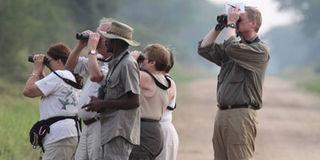Countdown to a richer national birding archive

The Big Birding Race increases the number of recorded bird species to attract more tourists. courtesy photo.
What you need to know:
- Big birding day. Every year, groups of birders race to spot and record bird species in order to demonstrate the potential of bird tourism in Uganda.
Uganda’s 14th annual Big Birding Day was ushered in by a 24-hour bird race, starting at midnight on Friday November 10 and expected to conclude today at the stroke of midnight.
During the race, groups of birders, each with a team leader and secretary go out into designated areas across the country to compile a list of bird species recorded. Only free-flying birds are recorded. The group with the highest registered number of birds is declared winner and awarded at the prize giving ceremony.
Some of the areas to be covered include; Mabamba Ramsar site, Mabira Forest, Botanical Gardens Entebbe and Lutembe Beach, among other sites around the country.
This year’s prize giving ceremony dubbed Big Birding Festival will be held at Uganda Museum Gardens on Saturday November 18. The events are organised by Nature Uganda in conjunction with Uganda Tourism Board(UTB), Uganda Wildlife Authority(UWA) and Uganda Safari Guides Association/ Uganda Bird Guides Club under the theme: “ Connecting Birds to People and Nature”.
From passion to cash cow
Besides creating awareness of Avitourism and bird conservation, the other purpose of the national event is bird data collection for people to get to know the number of bird species in different countries. “Cornell Lab of Ornithology, the supreme bird data collector encourages people to do 24-hour birding and Big Birding Day (BBD) has turned out to be a major birding event across nations,” says Johnnie Kamugisha, the winner of the Big Birding race 2009 and Chairman Uganda Bird Guides Club.
The day was observed as a hobby for most bird watchers, until the Cornell Lab established ebird, an online checklist programme to increase accessibility of bird observations made by bird watchers.
Government support
This year, Uganda Tourism Board (UTB) boosted the event as a followup to the 2017 African Bird Expo that attracted Laura Kammermeier, Hugh Powell, Nathan Swick, Allan Davis and other celebrity birdwatchers from all over the world. UTB has injected close to Shs40m according to marketing manager, Edwin Muzahura.
“We have supported BBD since inception. We fund the launch, the field activities such as transport, refreshments and the award ceremony at the climax,” he explains. In UTB’s mandate to promote tourism in partnership with the private sector, Big Birding Day is a platform for the government agency to market birding as a special product where Uganda has an edge both on the domestic and international scene.
Origins of birding event
The Big Bird Race in Uganda was pioneered in 2001 by eight Uganda guides; Herbert Byaruhanga, Johnnie Kamugisha, Alfred Twinomujuni, Hassan Mutebi, Samuel Bamwesigye, Livingstone Kalema, Elias Kabogoza, and Robert Bahinda with the assistance of Patrick Cardwell, former managing director of Uganda Breweries Limited (UBL) and one of South Africa’s top 10 birders. The guides decided to partner with Nature Uganda to bring the event to life. Patrick Cardwell encouraged the guides to generate income from bird checklists. “He told us to sell them to tour operators who paid for every bird observed,” explains Kamugisha. The money was used in conservation and training bird guides.
“Under Cardwell, UBL sponsored a lot of birds, several tour operators such as Kelly McTavish got onto the sponsors’ list and the money collected on the Big Birding Day facilitated Alfred Twinomujuni to get training in South Africa,” he adds.
Uganda currently has more than 1,078 bird species which is more than half of Africa’s bird count estimated at 2,010 species. UTB CEO Stephen Asiimwe reveals that Uganda has 11.2 per cent of the world species.
Despite the large count in Uganda, Kamugisha cites major setbacks such as tourism marketing due to little funding and limited knowledge, poor infrastructure in form of roads and unskilled labour. “On average, one bird watching client pays $5000 (Shs18m) for a 14-day trip and a group consists of six tourists,” he explains.


